
Dock of the Bay

Volume VII Number 3
January 22-28, 1999
I Plunged: Submersing in the Near-Freezing Bay
photos by Bill Lambrecht Nathaniel Knoll taunts his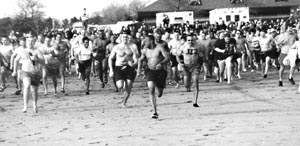 brother Alex with
his youthful recovery.
brother Alex with
his youthful recovery.
The thermometer had climbed above 40 degrees, but with the wind gusting 10 and 20 miles per hour, the air hitting bare skin was well beneath freezing.
And there was plenty of bare skin last Saturday at Sandy Point State Park, as I joined some 1,000 other brave - or as everyone who'd heard my plan said, crazy - men and women to test the Bay's waters in the third annual Polar Bear Plunge.
Clustered together, perhaps for warmth but more likely for the courage
instilled through group behavior and camaraderie, we waited for the signal
that we could get this over with.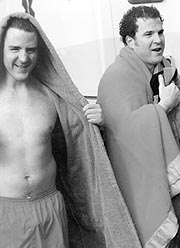
And wait we did. Last year, some 800 people gathered for the Maryland State Police's fund-raiser benefiting Special Olympics. But this year drew 20 percent more, bogging down registration, at which participants handed over their minimum of $50 in pledges and signed waivers stating something to the effect that if the water induced cardiac arrest, Maryland Special Olympics and the state troopers would not be held liable.
Even with the slow-moving line, the atmosphere was carnival-like, as people met and chatted, a bit giddy at what we were about to do. Adding to the festive air were the costumes. One couple came dressed as caveman and cavewoman, looking like Fred and Wilma Flintstone, only colder, their bare flesh goose-bumping visibly from 15 feet. Another man was dressed as an overgrown Telletubby. Baltimore Ravens defensive end Michael McCrary, who last year wore a pink tutu, wore more macho attire, appearing as Crocodile Dundee.
At one point we were told we were lucky, because last year the water had been recorded at 35 degrees; this year that temperature had climbed to 37. It could be worse, I reasoned, since saltwater doesn't freeze until 29 degrees.
Still, water this cold is hard to comprehend.
I, like many others, wore aqua-socks as recommended by Plunge organizers. Even so, ground chill seeped from the sand, through the rubber and polypropylene of the aqua-socks into my feet and legs. How, I wondered looking at some plungers, are these people standing in bare feet?
Before I could think further on the matter, the crowd surged forward, a wave of lemmings rushing toward wintry water that we're all warned to stay away from.
To build up a last surge of body warmth, I sprinted, trying to ignore
the one-foot waves crashing to shore.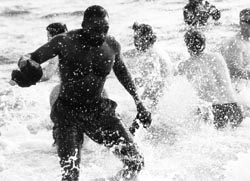
I have no words to accurately describe what happened next to anyone who has not experienced the death-like chill with which water this cold grabs you.
My lungs gasped inward of their own accord, leaving me holding my breath.
My mind shouted 'turn around, get the hell out!'
But I had made a wager with my younger brother, Nathaniel, also plunging, and I was not going to retreat so easily.
I splashed onward, until the water was above my waistline, tickling my rib cage with near-frozen fingers.
Despite rules advising plungers not to dive or submerge, I did just that, dropping beneath the surface.
Before this, my brain had held back my body's impulse to flee. Once submerged, I did not question the rule "do not linger."
By this point, I had been in the water little more than a minute - if that. Trying to stride toward shore, I now experienced what I have only read or been told about - the almost instantaneous onslaught of cold shock.
My body was shutting down, my limbs no longer obeying the commands shouted from my mind: Lift left leg, move forward; lift right leg, move forward.
Still, my limbs moved instinctively to escape the death-grip of this water.
So close to shore, but now another obstacle.
Having reached the water in the first wave of plungers, retreating I found my path to land, dry air and life blocked by a wall of plungers still advancing on the icy water.
Trying to dodge these human obstacles in knee-deep water, my feet stumbled, my legs gave way.
Again, I was in water up to my chin. But now my arms and legs were sluggish and weak, leaving me little strength to lift my body back onto my legs and out of the water.
I thought of the Cleveland Who concert wherein fans were trampled to death. How easily that could happen here, with the crowd pushing from above and pulling downward, death lurking beneath the surface.
A plunger grasps my arm above the elbow and I pull myself to my feet. How easy it seems, yet I wonder, were I alone in such water, if I'd have had the strength - or perhaps after a minute in freezing water, the will - to lift myself out.
At the Polar Bear Plunge there were no such worries. Had I sat, floated or sunk in the Bay, countless rescuers waited - including divers in full red rubber survival suits. Two ambulances, engines running, waited on shore, just in case.
A few minutes later, wrapped in a thick, warm blanket, I leaned against one of those ambulances as I sipped hot tea and exchanged stories with my brother, who had also plunged in head-first. We weren't alone, I later found out. Lt. Gov. Kathleen Kennedy Townsend - whose aunt Eunice Kennedy Shriver founded Special Olympics - had also dived in.
All in all, more than $200,000 was collected for Maryland Special Olympics from the pledges raised by plungers like myself. Truth be told, I'd do it again. If nothing else, the protein and carb-loaded steak, chicken and rice lunch provided to plungers by Outback Steakhouse was enough to refuel my jets. And the plunge is for a good cause. It is an even better test of one's own body and the extremes of its limits.
-JAK
In Southern Anne Arundel, Walking the Walk in King's Memory
photo by Paul Rensted
In the gray and rainy January evening, 100 people gather outside the Tri-Me Market in West River to march to Franklin United Methodist Church in Churchton. As they walk, their pastor, the Rev. Jimmie Ward, leads them in civil rights songs.
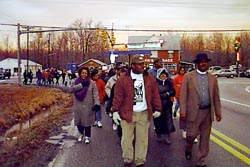 In the mist, you might believe you
have traveled back in time to the dreaming days of the 1960s. In fact, Dr.
Martin Luther King Jr., whose birthday Southern Anne Arundel County's African
American community is celebrating, has been dead almost 31 years. Tonight's
march and meal, together with the music and messages of the church service
that follows, testify to the challenge of honoring a man whose legacy calls
the living to action.
In the mist, you might believe you
have traveled back in time to the dreaming days of the 1960s. In fact, Dr.
Martin Luther King Jr., whose birthday Southern Anne Arundel County's African
American community is celebrating, has been dead almost 31 years. Tonight's
march and meal, together with the music and messages of the church service
that follows, testify to the challenge of honoring a man whose legacy calls
the living to action.
One of several ministers recalling King's legacy, Rev. Michael Armstrong of Carter's United Methodist Church, challenged the congregation "to work to fulfill Martin's dream - but also to dream new dreams." Taking issue with Langston Hughes' poem, Armstrong asserted that "dreams deferred do not mean dreams denied." He recalled that King described his dream as a nightmare only "when we as a nation do nothing."
The themes of "doing something" and using the work of past to combat racism ran throughout the evening's events.
Musician Dale Hoskins sang about today's problems, urging parents to assume responsibility both for their children and for the well-being of the community at large. That theme was picked up by FBI agent Louie McKinney, of Annapolis. Citing a long list of disturbing statistics - from the homicide rate to AIDS - he urged the community to responsibility.
But there has been progress, too, said McKinney, noting that without the work of King and the Civil Rights movement, he would not have had the opportunity to work for the FBI.
When the evening ended as it had begun, with the singing of "We Shall Overcome," all knew that the burden of realizing King's anthem was theirs.
Paul Rensted
Rensted, of Fairhaven, marched with his African American neighbors.
Calvert Grabs the Light(house)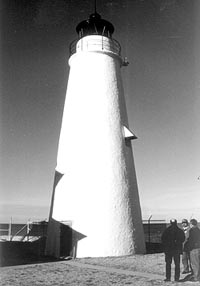
photos by Mark Burns
Time used to be that Cove Point Light was an off-limits kind of place surrounded by chain link fence with "no trespassing" signs scattered about.
It still is.
But not for long. After three years of negotiations, Calvert Marine Museum is finally set to take control of the lighthouse and Coast Guard compound. This rounds out the museum's lighthouse collection to a nice, round two and a quarter, the others being Drum Point Light and pieces of Cedar Point Light.
Cove Point Light makes an attractive addition to the museum's collection. It's a short tower-style lighthouse, built of brick, stuccoed and whitewashed. A package deal, it comes complete with a three-story keeper's house and tiny bell shed. The museum is eager to have it.
So what are they waiting for? A functional bulkhead for one.
"Mother Nature has been trying to make this lighthouse disappear since 1830," says Doug Alves, director of the Calvert Marine Museum. The bulkhead was built in the 1920s to help keep waves at bay, but since then the Chesapeake has revised its strategy and eaten away at the earth from underneath - in effect doing a slow job of pulling the rug out from underneath the light.
But that's the Coast Guard's problem. Part of their deal with Calvert
County is that they fix the bulkhead before Cove Point is turned over. Only
then will the museum take over day-to-day upkeep. "The Coast Guard
told us 'We'll maintain the light bulb; everything else will be yours,'"
says Alves.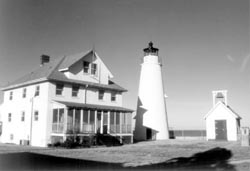
The Coast Guard will still control the light from Baltimore, and a crew out of St. Inigoes is charged with regularly maintaining it and the automated foghorn.
No big changes or renovations are planned. For now, at least, the fence stays. Some outdoor signage will be added, and the bell shed beside the light will house a modest exhibit with a handicap ramp to make it accessible. A few more cosmetic touch-ups may happen here and there. A shuttle will be started to link the lighthouse with the museum in Solomons. But that's it.
Cove Point Light, which has been active since 1828, will remain in service despite the claim by some that the light from the nearby natural gas platform in the Bay is more than bright enough. The keeper's house may eventually hold exhibits or become a bed and breakfast, though for now such ideas are simply speculation.
It's expected that the grounds will be open as a satellite of Calvert Marine Museum by the summer of 2000. Visitors managed a sneak preview of the withdrawn lighthouse for the first time during the Winter Lights celebration on January 16, but they and the rest of us aren't allowed back until next summer.
-MRB
In Annapolis, Postal Rates Increased
by Power of X
photo by Nathaniel Knoll
On the birthday of Dr. Martin Luther King Jr., Jan. 15, another hero in African American history was paid homage as the U.S. Postal Service unveiled the 22nd stamp in its Black Heritage series. Honored was Malcolm X, whose portrait commemorative stamp is the second issued at the new 33-cent rate.
The stamp features X's photograph as taken by an Associated Press photographer at a New York City press conference on May 21, 1964, nine months before X's assassination.
The Black Heritage stamp series honors the individual achievements of African-Americans. "It's a wonderful opportunity to learn and educate," explained George Norberg, manager of the Eastport Station post office.
Held at The Banneker-Douglass Museum in Annapolis, the state's official repository for black history, the ceremony was attended by some 40 people including postal and city officials, community leaders and Annapolis Mayor Dean Johnson. The stamp, officially issued Jan. 20 in New York City, had a second Maryland unveiling in Columbia.
"This is a testimony to his belief in life, liberty and the pursuit of happiness," said Abdul Khalia, of Annapolis, of the unveiling.
Born Malcolm Little in Omaha, Nebraska in1925, Malcolm X turned from a street life to embrace the Muslim faith, becoming a loyal member of the black Muslim group, The Nation of Islam.
X's strong views on racial separatism fueled debate as well as strategies for social change. After becoming the most visible and outspoken member within the The Nation of Islam, X was eventually exiled from the Nation.
During X's subsequent pilgrimage to Mecca, the Islamic holy city, he embraced traditional Islam and, with time, modified his views on separatism.
Changing his name to El-Hajj Malik El-Shabazz, X broke away from The Nation of Islam and disavowed his earlier separatist preaching. He organized an independent movement to put his new ideas into effect and championed a more integrationist solution to racial problems.
On Feb. 21, 1965, while speaking to followers at a Harlem rally for his newly founded Organization of Afro-American Unity, X was shot to death. His assassins remain unidentified.
One of the most influential black leaders of the century, X was a true martyr, and many people like David Harris of Annapolis feel that "it's about time" he received such an honor. "This speaks much of what he did," said Mahmoud Baptiste, of Annapolis.
-NMK
In Virginia, the arrogant remarks of New York City Mayor Rudolph Giuliani about taking trash continue to rankle Virginia. Virginia and other states are obligated to take the Big Apple's garbage in return for economic and cultural benefits reaped from New York, Giuliani said...
In Pennsylvania, the state's Fish and
Boat Commission for the third time has delayed a proposal to rank some
of the state's fish threatened or endangered because of objections from
the dredging, paving, coal-mining  and
home-building industries. They worry that the new protections will limit
shoreline development...
and
home-building industries. They worry that the new protections will limit
shoreline development...
Our Creature Feature comes to us from Montana, where those blonde little barkers - prairie dogs - are waiting for word on their future.
The U.S. Fish and Wildlife Service will announce shortly whether it has found sufficient cause to begin the process to categorize the black-tailed prairie dogs as a threatened species. Last year, the agency rejected a call to begin protecting them on an emergency basis.
Unfortunately for the prairie dogs, some state officials are fighting against the designation because, they feel, it amounts to federal intrusion.
| Issue 3 |
Volume VII Number 3
January 21-27, 1999
New Bay Times
| Homepage |
| Back to Archives |